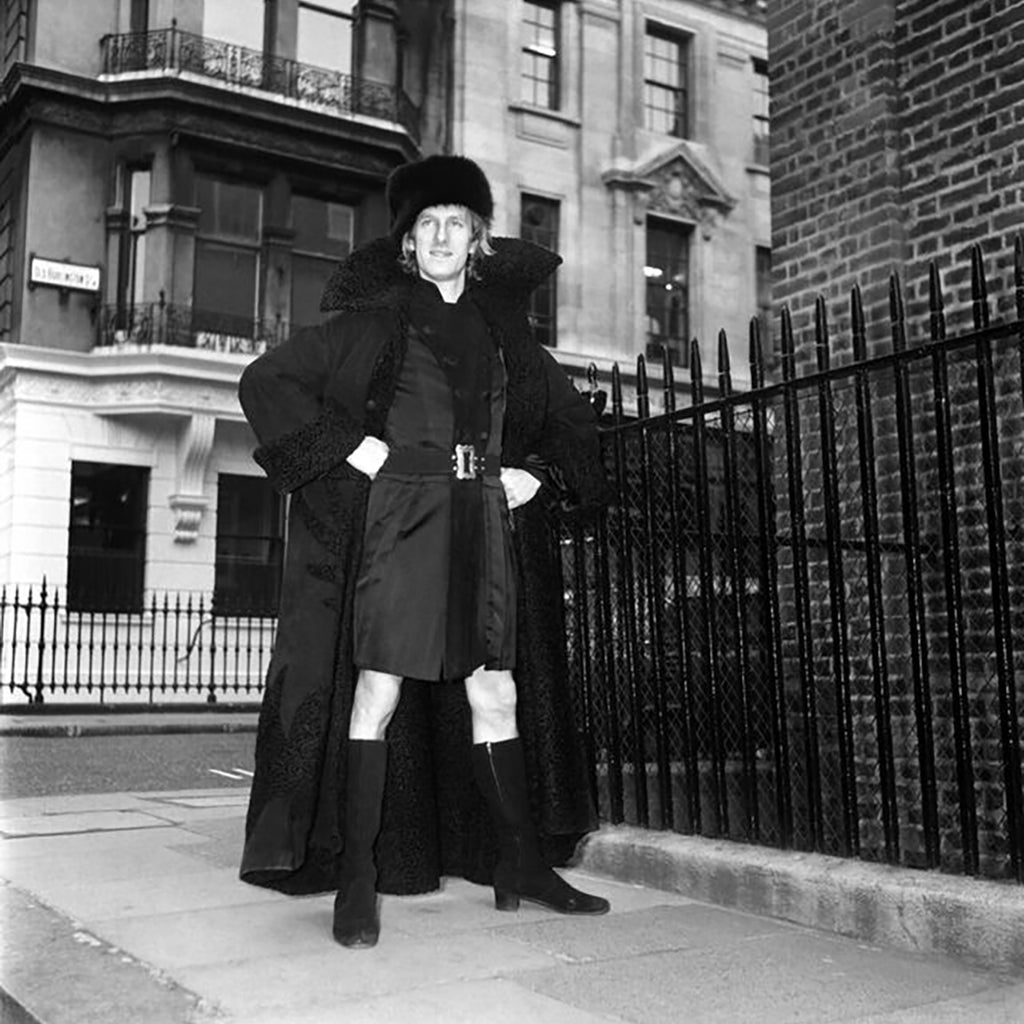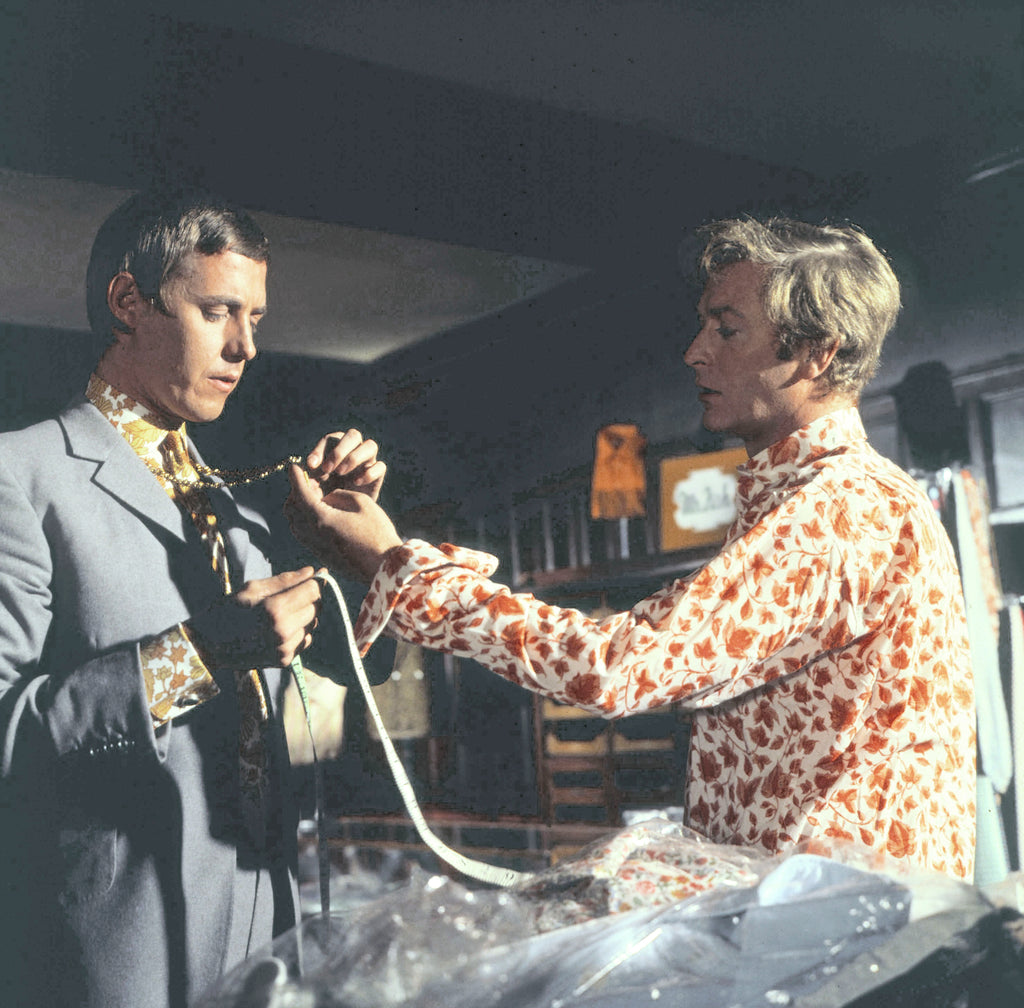With a reputation for swimming against the tide, Mr Fish did far more than change the sartorial rule book – he tore it up.

Michael Fish outside the Mr Fish boutique on Clifford Street, Mayfair (1968)
These days you might be forgiven for not knowing the name Michael Fish, but you would undoubtedly recognise his influence on men's fashion. Prior to the 1960s, men's suits, shirts, ties, and pocket squares all tended to be somewhat sober affairs. However, it was Michael Fish who changed all of that, ushering in the Peacock Revolution of colour and pattern that was perfect for the age of social liberation and the newly dandified man.

Michael Fish: The leader of the Peacock Revolution (1970)
His creations adorned both rock stars and royalty, artists and aristocrats, from David Bowie and Mick Jagger, to Pablo Picasso and Lord Lichfield. It was Michael Fish who introduced a whole new way of looking at men's fashion, dusting off the cobwebs and creating clothes that sang with colour and texture.

Lord Lichfield modelling Mr Fish clothes (1971)
Despite having made such an indelible mark on menswear, Michael Fish came from humble beginnings. Born in Wood Green in 1940, Fish had no formal education and started working at age 15 cleaning counters at the Colletts department store on Shaftesbury Avenue, where he was trained by legendary shirt-maker, Kenneth Williams.

Michael Fish began his career amid the bright lights of Shaftesbury Avenue in 1955
It wasn't long before Fish was moving onward and upwards, first at the Jermyn Street Shirtmaker, then on to New & Lingwood, and eventually joining Turnbull & Asser where he was first able to leave his mark. During his time there, Michael Fish had a rather auspicious customer - one who would play just as significant a part in the company's recognition and good fortune: Sean Connery.

Michael Fish and Sean Connery at Turnbull & Asser (1962)
Terence Young, the director of the first James Bond film, "Dr. No", introduced Connery to the shirt-maker. Young had taken the diamond-in-the-rough actor in hand and set about refining him into the perfect gentleman spy, sending him to his own tailor, Anthony Sinclair, and then to Michael Fish who first measured and fitted Connery for his cocktail-cuff shirts which would go on to become an integral part of the 007 look.

Michael Fish adjusting Sean Connery’s cocktail cuffs (1962)
With his burgeoning success and reputation, it was suggested to Fish by his future business partner, Barry Sainsbury, that he should branch out on his own and so, in 1966 Michael Fish opened his eponymous store on Clifford Street, midway between Bond Street and Savile Row - far enough away from the dandified offerings on Carnaby Street to give it the air of exclusivity it rightly deserved.

Michael Fish outside the Mr Fish boutique on Clifford Street, Mayfair (1969)
With both Michael's loyal customers and Sainsbury's family name and extensive social connections, Mr. Fish was an immediate success. The shop soon became an essential stop on the Peacock's shopping circuit, drawing in a newer, younger customer, one who helped break down the traditional social barriers.

Michael Fish and Barry Sainsbury (1968)
From the outset, Mr. Fish represented the very best quality fabrics, with the very best design and construction, which were represented in the price. If Mr. Fish was expensive - and it was - customers could always console themselves in the fact that not only were they buying the very best quality, the very latest in cutting-edge fashion, they were also in good company.

Michael Fish waiting to greet customers to his boutique (1970)
From the very beginning, Mr. Fish attracted Lords, Ladies, artists, musicians, athletes, and celebrities from all walks of life. Customers included Noel Coward (whose pink silk and gold dressing gown - a gift from Vivien Leigh - was something of a favourite), James Fox, Jimi Hendrix, Sammy Davis Jr., Rock Hudson, Duke Ellington, Mama Cass, Princess Margaret, and Vanessa Redgrave, and many, many more.

Jimi Hendrix: a regular recipient of the Mr Fish experience
In addition to an A-list clientele, Mr Fish became notorious for extravagant design. Numerous fashion designers have been credited with creating a look, but few have the distinction of inventing a product that is named in their honour. Mr Fish widened the blades of his ties to such an extreme they began to resemble a kipper (a popular British breakfast dish of smoked herring that is split butterfly style) and thus, also being derived from a “Fish”, the Kipper Tie was born.

Mr Fish Kipper Tie (1967) at London’s V&A Museum
Undoubtedly, the most controversial of Mr Fish designs was the “Man-dress”. The most famous examples were worn by Mick Jagger during the Rolling Stones free concert at Hyde Park in 1969, and David Bowie the following year for the cover of “The Man Who Sold the World”.

Stones in the Park (1969)

The Man Who Sold The World (1970)
A large part of Mr. Fish's success was Michael Fish himself. He was gregarious, charming, and had a witty, self-depreciating sense of humour, which found him turning clients into friends. He was as much a part of the scene as those he dressed. Mr. Fish, with its famous clientele, direction-defining mens' fashion, and international recognition, arguably became the most well-known designer boutique of its day.

Michael Fish wearing a man-dress and full-length leather maxi-coat
Mr. Fish was such a symbol of the change in the times that in "The Italian Job" there is a scene where Michael Caine's character (who has been at Her Majesty's pleasure for the last few years) makes a visit to the Mr. Fish boutique. The colourful shirts offered are in stark contrast to the plain shirt Caine wears, and this scene is used to demonstrate just how things have changed over a short period of time. It also demonstrates just how big an influence Michael Fish had on the world of men’s fashion.

Michael Caine in a scene from The Italian Job at the Mr Fish boutique (1969)
The Mr Fish boutique traded for just 8 years. During this period, Michael Fish achieved more than most designers could dream of accomplishing in a lifetime. His swansong was undoubtedly the African inspired boxing robe that he designed and made for Muhammad Ali’s “Rumble in the Jungle” with George Foreman in 1974. Sadly, the business closed that year after a fire consumed the premises, but the legacy of Mr Fish continues to burn bright.

Muhammad Ali's boxing robe designed by Mr Fish for the 'Rumble in the Jungle'
Over 40 years later, the brand has been revitalised, once again with high-quality shirting as the primary focus. A commitment to quality and style remain at the forefront of today's business… with a healthy dose of the peculiar Mr. Fish flamboyance.
Click here to learn more about Mr Fish.
